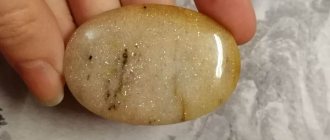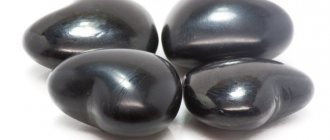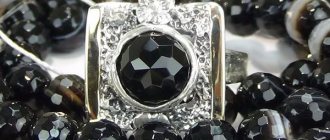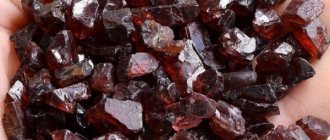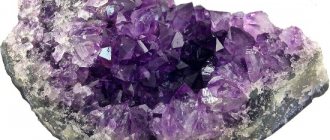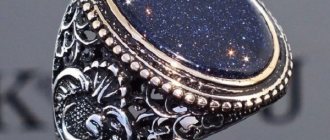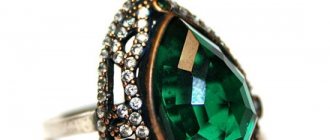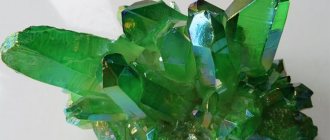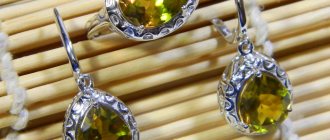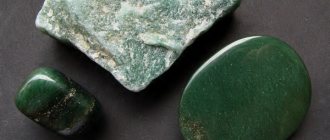History and origin
Tourmaline was known to the healers of Ancient Rome, Byzantium and Rus' (XIV century). Three hundred years later, Europe became acquainted with the stone. The history of the appearance of the gem on the continent is connected with Dutch sailors.
They brought these minerals from the island of Ceylon, which became fashionable. Soon, Ceylon's wealth was plundered by greedy merchants looking for “rubies” and “emeralds”.
Tourmaline
The term "tourmaline" in the local dialect means "stone that attracts ash" or "magical multi-colored stone."
The legendary gem in the form of a bunch of grapes is the “Caesar's Ruby”. According to legend, Cleopatra gave it to Caesar. Then traces of the stone were lost, it wandered around the countries until it came to the Swedish king in the 18th century. Gustav VIII presented it to Russian autocrat Catherine II.
From the day it appeared, the “bunch of grapes” was considered ruby. Only in the 20th century did they find out that this is Burmese pink tourmaline. The jewel is the property of the Diamond Fund of Russia. Another famous Russian artifact is the 500-carat stone in Anna Ioannovna’s crown.
How to protect yourself from fakes
Blue tourmaline is a stone that is not synthesized in large quantities in laboratories. This process is quite unprofitable from the economic side. Famous craftsmen use natural stones to make jewelry, while dishonest sellers replace the mineral with a cheap analogue. The substitute can be made from a polymer of the desired color or blue glass.
There are several tips to help you identify a fake in a store before purchasing a product you like:
- First you need to hold the stone in your hand for 1-2 minutes. A real crystal stays cool and you can feel it; a cheap imitation heats up over the same period of time.
- Real indigolite is capable of changing color depending on the intensity of light in the room. Imitated tourmaline made of glass and polymer has a uniform color and this does not change under any conditions.
- You should definitely look at the stone offered in the store under a magnifying glass. If the seller demonstrates a fake, you will be able to see small air bubbles inside the glass or polymer. This is not the case in natural stone.
Before purchasing, it is important to check all documents, assessment certificates and product quality.
Physicochemical characteristics
Tourmaline contains at least 25 elements, but the chemical composition of the stone is variable.
The dominance of any impurity creates the main color of the mineral. One crystal can have several colors.
| Property | Description |
| Formula | Na(Li,Al)3Al6[(OH)4|(BO3)3Si6O18] |
| Color | Pink, red, orange-brown, green, blue, red-violet, colorless, black, polychrome. |
| Shine | Glass |
| Transparency | From transparent to opaque. |
| Hardness | 7-7,5 |
| Cleavage | Unclear |
| Kink | Uneven, small-shelled; fragile. |
| Density | 3.02-3.26 g/cm³ |
Industries of use of tourmaline
Large tourmaline crystals are used in radio engineering.
Their piezoelectric properties are used as a source of negative ions for medical devices (health mattresses, pillows, lumbar belts, knee pads for improving the musculoskeletal system). According to the color characteristics and degree of transparency, various types of tourmalines are classified as either precious or ornamental stones. The most valuable are transparent samples painted in green, blue and crimson-red, as well as polychrome green-reddish ones. They are widely used in jewelry as inserts in a wide variety of jewelry: rings, pendants, earrings, brooches, etc.
Varieties and colors
The stone has several colors and shades of different values. The gem is similar to the first level precious minerals - emerald, sapphire or ruby.
Colors
In mineralogy, tourmalines of different colors are called:
- verdelite - green;
- rubellite - pink-red;
- indigolite - blue;
- dravite - yellow and orange-earth tones;
- sherl - black;
- achroite - colorless.
Green
Externally, the stone looks like an emerald, which is why it is loved by jewelers. Green crystals are found in many places on the planet, but each has its own color saturation. The most beautiful and valuable tourmalines are named after the place where they were mined, Brazilian emeralds.
Green tourmaline
Pink
The hue is created by manganese: the more of it, the brighter and more saturated the crystal. The full range of stones ranges from tea rose to purple.
Pink tourmaline
The mineral was popular with European monarchs, who ordered “almost ruby” inlay into their crowns.
The stone is mined in Madagascar, California (USA), and Russian Transbaikalia. The largest pink specimens (up to half a meter) are produced by Brazil.
Black
The mineral owes its mystical color to iron. More often used as an ornamental stone, rarely as a jewelry stone.
Black tourmaline
Blue
An expensive variety of stone of the full range. The main color, often with a greenish tint, is due to iron impurities. Deep blue shades are rare; such specimens are used for luxury jewelry.
Blue tourmaline
Due to its external similarity, the mineral is known as Siberian, Brazilian or Oriental sapphire.
The stone turns green as a result of heat treatment. Jewelers take advantage of this, presenting such tourmaline as an emerald crystal.
Brown-yellow
Also known as dravite. The second name was given in honor of the Australian Drava River, where it was first discovered. Rarely used as jewelry.
Brown-yellow tourmaline
Achroite
A colorless mineral with bluish or greenish tints.
Tourmaline achroite
Externally, achroite tourmaline is such an inconspicuous stone that no one pays attention to it. Reveals after cutting. Rare valuable species. It is found only in the vicinity of the Italian city of Elbe.
Varieties
There are several popular varieties of the mineral:
Paraiba
An expensive and bright variety of natural tourmaline, a dream for jewelers and collectors. The stone palette ranges from blue to emerald, with a neon glow effect. It's rare to find, so it's expensive. It is formed only in rocks of the Brazilian state of Paraiba.
Paraiba
Watermelon
An original representative of the tourmaline family. Watermelon tourmaline is a combination of red-pink, white and green shades flowing into each other. But clear boundaries between the colors are preserved, creating a resemblance to a slice of watermelon.
Watermelon tourmalite
Burmese
This type of natural tourmaline stands out due to its shape. The stone is cut perfectly, but the inside looks scratched. The color palette of the mineral ranges from ripe garnet to dark purple.
Burmese tourmaline
The color of the Burmese stone imitates congealed blood; it makes a pendant or pendant look impressive.
Sibirit
A deep crimson or reddish-purple variety of the stone, reminiscent of rubellite, mined in Russia.
Siberian tourmaline
Chameleonite
The stone changes color under different lighting conditions. In artificial - a reddish-earthy glow, in daylight - a green tint with an olive tint.
Necklace with chameleonite tourmaline stone
Chrome tourmaline
A bright green stone with a high percentage of chromium.
Chrome tourmaline
The color is closest to emerald, but less shiny.
Color range and varieties
With an amazing variety of colors of transparent crystals, tourmaline is one of nature's beautiful creations. This gem emits the same electrical energy as the human body pulses with a charge of 0.06 mA. It is charged with electrical energy from the Sun. There are monochromatic and polychrome minerals, with almost all the colors of the rainbow. Depending on the color, the physical properties of tourmaline may change, as well as its energy.
Varieties of tourmaline are determined by properties, color, and deposit. The varied rich palette of shades of the mineral is provided by a complex composition, which includes about 26 chemical elements of the periodic table. Popular jewelry tourmalines contain a lot of alkali metals: sodium, potassium and lithium, which ensures the variegated attractive color of the crystals. The presence of trace elements such as magnesium and calcium, manganese and iron, chromium and vanadium determines the extraordinary colors of this valuable mineral. The presence of lithium colors the stone red, magnesium gives it a brown tint, and sodium gives it a yellow tint. Iron gives black color to crystals.
The following types of mineral are known:
- Black tourmaline sherlite is an opaque mineral that contains an increased amount of iron. Bioenergetics specialists explain that this color helps to create a field around the owner that is not affected by physical radiation, helping not to be subject to mental influence. Can be processed and has an electrical charge. Helps the owner to maintain calm and a mystical mood.
- Indogilite, a variety of deep blue indigo, is universal among astrology experts. It is not inferior to sapphire in its beautiful appearance. The elements that make up the mineral determine the shades. In nature, indigolite is blue-green in color, with a shade of sky blue, similar to aquamarine. The blue gem is considered a symbol of peace and love,
- Watermelon tourmaline amazes not only with its unique beauty, but also with its hard structure and increased resistance to physical influences. The mineral has a pink middle with a green frame, reminiscent of a striped berry. Many jewelers refuse cutting and simply cut it into plates; the mineral appears in its individual unique beauty. This beautiful stone is naturally endowed with powerful energy, has the ability to emit infrared radiation that is beneficial to the human body, as well as block electromagnetic waves and ionize the air in the room.
- Rubellite is a pink tourmaline that belongs to the second class of precious gems. Rubellite is translated from Latin as reddish and is considered the most sought after variety. It has a rich palette of different shades, ranging from light pink to purple-red. Such a rich, bright shade depends on the amount of manganese in the mineral. Raspberry-cherry colored rubellite found in Siberia is called sibirite.
- Verdelite stands out among tourmaline varieties due to its beautiful green color. It is one of the noble species among tourmalines. This noble color of the stone comes from an admixture of iron compounds. Verdelite surprises mineral lovers with shades of soft grassy and dark emerald green. Unevenly distributed impurities create a bizarre play of colors in the crystals of this variety. There are verdelites whose tops are red and rubellite.
- Paraiba. The mineral has a stunningly beautiful color: rich emerald green, crimson and blue shades of a transparent structure.
- Chameleonite. As the name suggests, the mineral changes its crystal color depending on the light source. In daylight it appears emerald green, and in artificial light it strikes with an amazing red sheen.
- Burma tourmaline is called scratched. The color of the mineral ranges from garnet red to dark purple. Its peculiarity is that on the outside of the stone the surface is smooth and transparent, but inside the gem, stripes in the form of scratches are visible.
- Achroite is a colorless tourmaline of volcanic origin, a rare type of mineral, and is one of the most valuable gems. Its crystals are elongated-prasmatic, needle-shaped. It is also called Elbaite, as it was found on the Elbe River in Germany. Refers to allochromatic minerals. The stone reflects all the colors of the rainbow and is distinguished by strong pleochroism. Some crystals with needle-shaped microinclusions may have a cat's eye effect.
- Yellow tourmaline is a rare type of gem, containing a lot of magnesium and potassium, which give it such an unusual color.
- Varieties of tourmaline include dark green and brown dravites.
- Chrome tourmaline is a rich green color, similar to emerald, the mineral acquires this shade due to the increased content of chromium in its composition.
Medicinal properties
Tourmaline is unique in that its physical characteristics are also medicinal.
The Curies also discovered the identity of the electrical radiation of a mineral and the human body.
Physical parameters
The properties of natural tourmaline stone act as medicine in several areas:
- Warming up. Crushed crystals create a warming effect.
- Ionization. The mineral polarizes, ionizing the air. Negative ions speed up recovery after illness or surgery.
- Infrared radiation. Tourmaline emits infrared rays. They reach problem areas of the body, triggering cell restoration.
The healing effect does not depend on the size of the crystal; tiny stones are more effective than large ones.
Tourmaline
Color Specialization
The healing properties of tourmaline are determined by color or variety:
- green - the mineral strengthens the immune system, activates blood circulation, inhibits aging and rejuvenates; treats pathologies of the heart, kidneys or liver;
- blue - supports immunity and eliminates hormonal imbalances;
- Paraiba - the stone is beneficial for men (heals the reproductive system);
- pink, red - the gem heals the skin and lungs;
- yellow - acts as a sedative and stabilizes emotions;
- black - for the disease to go away, you need to twirl the black tourmaline crystal over the diseased area or on the skin counterclockwise.
The healing magical properties of tourmaline are a salvation for those people whose home or place of work is located in a geopathogenic zone.
Contraindications
The beneficial effect of tourmaline on the body has been proven, but there are contraindications. Medical stop factors:
- pregnancy or breastfeeding;
- problems associated with thyroid diseases;
- high body temperature;
- bleeding or hemorrhagic strokes;
- age under 12 years.
Tourmaline is placed on injured soft tissues a day later. Allergy sufferers and people with pacemakers should use the mineral with caution.
Medicinal properties of dravite
First, it is worth noting the fact that tourmaline and all its forms have a very strong effect on the nerves of every person who has the opportunity to come into contact with it. It is usually recommended to be worn by those people who suffer greatly from the inability to sleep. Moreover, regardless of whether these problems are chronic or temporary. According to some reports, it can even bring people back from depression. If there is darkness in a person’s soul, then this particular variety of tourmaline will correct everything. The stone can relieve a variety of phobias. But if we talk about mental health, from a physical point of view, it improves metabolism and completely normalizes all the processes that take place in the human body.
Magic properties
The magical feature of tourmaline is the creation of a protective field around the owner.
The magic of the mineral neutralizes not only mental negativity, but also physical negativity: radiation from a TV, computer, microwave, and other electronic devices. The pebble is placed on the apparatus or next to it.
The magical effect on a person is determined by the color of the stone:
- green - needed by those who do not believe in themselves; the talisman will tell you a way out of a hopeless situation;
- red is a gem for people concerned with the attention of the opposite sex;
- pink is a popular ladies’ talisman, it pacifies, relieves self-criticism and helps to endure life’s troubles;
- watermelon - the stone will make the owner responsive and condescending to people, teach him to express thoughts correctly; will help those who have lost faith in love or have lost hope of organizing their personal life; increases libido levels, but the woman will become loving;
- raspberry - an attribute of creative people;
- lilac is a talisman for overly emotional people;
- blue is a godsend and salvation for those who put family values above all else. Crystals the color of the summer sky in silver will ensure the peace of the family nest and the inviolability of marriage bonds;
- Paraiba - the influence of the stone will help you live in harmony with yourself and the world, look into your own subconscious and relieve depression;
- achroite - neutralizer of emotional explosions;
- indigolite is an attribute of scientists, philosophers, or those on a spiritual quest;
- brown - the stone hardens spiritually and physically, a ring or bracelet makes the owner inaccessible to negativity; amulet for the elderly;
- black - sherl does not attract or emit energy, but forms a shield field around the owner from any influence (including electromagnetic waves); a ring or earrings with it are suitable for pathological jealous people, haters or similar persons to reduce the degree of emotions.
Self-respecting witches or sorcerers consider black crystals a mandatory attribute for protection from “colleagues.”
Jewelry with tourmaline stone
The magical properties of black tourmaline help you find yourself or find the meaning of life. Sherl clears her mind by focusing on her goal.
Multi-colored gemstones are chosen by well-rounded, life-loving people.
Prices for tourmaline products
The average cost of tourmaline is about $40 per 1 carat.
But, for example, Paraiba is valued at much more expensive - $6,000 per carat, some of the rare Russian varieties reach $10,000 per carat. The higher the transparency and purity of the crystal, the more expensive it is. Recently, prices for tourmaline have increased significantly - about 70 times.
Who is suitable according to their zodiac sign?
According to the horoscope, tourmaline stone suits several zodiac signs.
The color of the stone matters:
- Leo, Libra or Aries - green or pink;
- Taurus, Sagittarius or Aquarius - blue;
- Capricorn - pink;
- Scorpio is black.
For Gemini, Pisces or Cancer, a pebble of any color will suit them.
| Zodiac sign | Compatibility (“+++” – fits perfectly, “+” – can be worn, “-” – strictly contraindicated) |
| Aries | + |
| Taurus | — |
| Twins | + |
| Cancer | + |
| a lion | + |
| Virgo | — |
| Scales | + |
| Scorpion | +++ |
| Sagittarius | + |
| Capricorn | — |
| Aquarius | + |
| Fish | + |
(“+++” – fits perfectly, “+” – can be worn, “-” – is strictly contraindicated)
How to recognize a fake
Artificial tourmaline is grown in laboratories and used for industrial needs. It is sold in large quantities at a fairly high price, but it is faded and inconspicuous. So scammers who want to invest as little money as possible and earn more do not buy such stones. As a rule, they prefer to imitate a gem using glass or plastic.
To determine where the tourmaline is natural and where it is fake, you can do a few simple manipulations.
- Try scratching your purchase with a needle or pin. Natural crystal is durable, you won't be able to do this.
- Examine the mineral against the light. Natural stones have pronounced pleochromism and play of light.
- Rub the stone with your finger. The natural specimen will become electrified, you will feel it.
- Bring a hair or piece of thin paper to the heated tourmaline. A real mineral should attract them. Such an experiment is very reliable because it determines the most striking, known property of a mineral.
Application area
Purity, transparency and color saturation determine the value of crystals. Tourmaline is divided into jewelry, ornamental or technical. Each type of stone has a meaning for a person.
Jewelry
Pure transparent stones are used for jewelry. The variety of colors of the mineral allows you to choose an option for women and men of any age or color type of appearance.
- Delicate tourmaline looks good in a set. Two or three jewelry (beads and a ring or a brooch and earrings) do not overload the image.
- Monochrome items are appropriate with a business suit, while a multi-color composition is suitable for less formal events.
The stone is iridescent and looks different in different lighting. Therefore, it is better to choose jewelry with tourmaline during the day.
Gems are set in gold, silver, cupronickel or jewelry alloy. Table or cabochon cut.
Pendant with tourmaline
The cost of the stone is $20–90 per carat. Exclusive specimens (for example, a flawless Paraibe) are valued at thousands of dollars. Prices for high-quality tourmaline are rising faster than for diamonds.
Medicine
Material rejected by jewelers is not thrown away. The healing properties of such tourmaline are indispensable for medicine:
- Air ionizers are installed in the bedrooms of sanatoriums or hospitals: negative ions speed up recovery.
- The crystals generate infrared rays (rays of life, as the Japanese believe), similar to human ones. They reach the deep-lying tissues of the body, starting their normal functioning until restoration.
- Heaters with tourmaline filling are a popular tool in the treatment of joints or back diseases. The smallest mineral crystals are attached to natural fibers. Belts, scarves, knee pads, elbow pads, insoles or thermal underwear are sewn from them.
For devices, procedures or products with tourmaline, pristine, unprocessed material is used.
The stone is used in medicine because it acts comprehensively, healing the entire body.
Industry
The beneficial properties of tourmaline as a piezoelectric or pyroelectric are used in the production of electronics and optical devices.
Tourmaline chips are added to coatings to increase refractoriness.
Transparent stones “help” measure underwater pressure at significant depths.
Types of tourmaline
Artificially grown crystals are also used for technical purposes.
Health benefits and harms
Tourmaline is the only mineral that has its own electric field and is rich in beneficial microelements. This combination turns the gem into a health factory with healing properties. Medicine also recognizes the healing resource of this wonderful natural stone, and tourmaline gives good results in treatment. The beneficial properties of the mineral have a beneficial effect on the human body.
- Vasodilation improves blood and lymph flow and heart activity
- Stimulates the functioning of the heart and liver
- Vessels are cleared of atherosclerotic plaques
- The functioning of the nervous system is normalized, metabolism is improved, and the immune system is strengthened.
- Blood plasma is charged with energy, sleep and oxygen supply to cells improve.
Products with tourmaline help rapid recovery from serious illnesses and injuries. Tourmaline crystals sewn into belts, rugs, and socks have a healing effect on the spine and joints.
Important. Products with natural tourmaline crystal protect the human body from electromagnetic radiation from computers, microwave ovens and other household electrical appliances.
Despite the healing properties of the mineral and its importance for humans, we must not forget that it has the ability to influence the biocurrents of the body. If used ineptly and without knowledge of the properties of the stone, in addition to its benefits, it can cause harm. In this regard, the mineral cannot be used for:
- cancer, elevated body temperature;
- tendency to bleeding;
- pregnancy in women and breastfeeding;
- the presence of a pacemaker, skin diseases, wounds.
In case of febrile conditions or increased body temperature, you should refrain from using tourmaline products.
How to spot a fake
Glass or a cheap gem is passed off as natural tourmaline. The difference between a stone and a fake is revealed by its physical characteristics:
- It will not be possible to scratch stone, but it will be easy to scratch glass;
- tourmaline is electrified, so it is heated, squeezed in hands or tinder, then brought to hair, ashes or cut newspaper. If they stick, it's a real stone.
Particularly sensitive people, when rubbing tourmaline, feel a tingling sensation in their fingers.
Let's analyze what the mineral looks like:
- tourmalines are heterogeneous in color, an ideal stone in this regard should alert you;
- the natural mineral is endowed with pleochroism, that is, a soft color transition;
- green or black stones are less commonly counterfeited.
A synthetic mineral can be created without problems, but the process of forming crystals is expensive and unprofitable.
Counterfeit protection
It is important to know how to distinguish a fake stone from a real one, so as not to accidentally purchase a fake for a lot of money. First of all, you should know about the hardness of this stone. The fake is quite easy to scratch, unlike the original. In addition, like any other tourmaline, this variety has the property of being electrified. You can easily rub it and if there is static electricity, it is immediately clear that this is the original.
In general, when talking about this stone, it should be understood that if a person is already aged, his zodiac signs can be classified as water or air, then, of course, this mineral should be purchased and worn. Dravit is able to give all people the opportunity to live fully, always be energetic and healthy. In addition, one should take into account the fact that it allows a person to significantly improve his own mental health and relieve him of unnecessary fears and worries. Same with physical health. Metabolism and the general condition of the body will always be in good shape.
Video on the topic: Samples from the dravite-uvite vein. Lipovka
How to wear and care
According to astrology, every day “curates” its own stone.
Earrings with tourmaline
If you wear the gem according to the rules, the properties of tourmaline will be maximized:
- Monday - verdelite;
- Tuesday - red;
- Wednesday - sherl;
- Thursday - indigolite;
- Friday - indigolite;
- Saturday - verdelite;
- Sunday - rubellite.
Tourmaline is energetically powerful. Even if the zodiac sign is suitable, you do not need to wear this stone all the time.
The mineral does not require complex care. Washing with warm running water every two to three months is sufficient. It is advisable not to delay the procedure.
History of tourmaline
People have known tourmalines for a very long time; these gems were set into gold back in Byzantine times, and then in Rus' they found their deposits, and craftsmen began to actively use this stone.
Later, tourmalines came to Europe, where they were brought by sailors from Ceylon. The aborigines called the mineral “turmali,” which translated as “the one that attracts ash.” This name was due to the fact that the stone became electrified when heated. — Advertising —
Expensive and beautiful tourmalines have always been valued by kings of various countries. They decorated crowns and made rich, exquisite jewelry from them. Today, tourmalines are also very popular in jewelry.
General properties of tourmaline
Tourmaline stone has a strong connection with divine energies. His task is to be a conductor of the laws of the Universe on Earth. Tourmaline connects the “higher” and “lower”, harmonizing cosmic and material energies. It is a symbol of internal and external harmony, indicating the path to internal balance.
The stone helps to improve understanding of yourself and others, relieves fears and gives confidence. Attracts inspiration, tolerance, prosperity. Able to transform negative thoughts into positive ones.
Jewelry with mineral
Tourmaline jewelry has been known for many centuries. One of these masterpieces is considered to be “Caesar's Ruby”. The pink crystal is kept in the Diamond Fund Vault. According to legend, Caesar gave a bunch of grapes made from a gem to his beloved.
Cleopatra appreciated the gift. The piece of jewelry wandered from one conqueror to another. In the 18th century it came to Russia. The Swedish king gives a bunch to Catherine. The decoration of Cleopatra's palace ends up in the possession of the Russian Empress. Caesar and his craftsmen believed that they made the jewelry from ruby, but modern scientists refuted their opinion. The cluster known for many centuries is rubellite.
The jewelry of modern masters is beautiful and delicate. They bring charm, freshness, and style to the owner’s image. The price of the products depends on the color, the originality of the shade, the shape and method of joining the crystals, their size and cut. There are a lot of indicators that change the cost of jewelry.
- Beads made from pink, red and green balls will cost from 700 rubles.
- Bracelets made of compressed ovals, rectangular plates, and translucent columns decorated in identical shapes - up to 5 thousand rubles.
- Delicate necklaces made of translucent peas, flat ovals of different colors - from 1800 rubles.
Also read: Carnelian - the meaning of the stone for a person
Cheap products can be found and bought at a cost of up to a thousand rubles. Jewelry that is complex in shape and work increases in price several times. Jewelers have found a new way to work with tourmaline. They make beads that can easily be converted into bracelets and decorate bags.
The rings change and become kulans and pendants. Working with the material is so interesting that it is rare that a master refuses such an opportunity. Even a non-professional can work with tourmaline beads. Needlewomen work with stone, decorating their works, realizing creative thoughts.
Tourmaline deposits
Tourmaline cannot be called too rare; its deposits are found throughout the globe. Namely: in Shi Lanka, Mozambique, Brazil, Burma, India and Angola. And also in Australia, USA, Canada, South Africa, Italy and Tajikistan.
Some of the best examples of tourmaline jewelry come from Afghanistan. On its territory there are a number of rich deposits such as: Kanokan, Jabo, Darae Pich, Chormax, Kantiva, Mualevi, Papru, Mandanesha and Tsotsum.
Mother Earth did not deprive our homeland of tourmaline either. Very high-quality jewelry samples are mined at the Malkhan deposit in Transbaikalia. Although you can find the stone on the Kola Peninsula and even in the Voroniki tundra. There would be a desire and at least a little opportunity.
Varieties
Tourmaline amazingly repeats numerous colors. Among the breed there are popular shades, rare and not of interest to masters.
Popular colors are:
- green;
- black;
- pink;
- blue.
Let's look at their features and magical abilities.
- Green mineral. Similar in appearance to emerald. One of the names is Brazilian Emerald. According to different deposits, green minerals have their own color saturation. Green samples affect the heart chakra. The heart becomes healthy, the person enjoys life, finds harmony, does not argue with himself, and enjoys what has been given to him from above.
- The pink mineral was loved by the monarchs of European countries. On their crown it was an obligatory component. The name of the pink rock is Rubellite. For a long time, tourmaline stones were mistaken for rubies, hence the similarity in names. The richness of pink comes from the presence and concentration of manganese. Such samples are mined in California, Russian Transbaikalia, and Madagascar. Large specimens are found in Brazilian deposits. Their length can reach up to half a meter.
- The black gem was obtained due to the concentration of iron in the mineral. Its scientific name is Sherl. This is the stone of sorcerers and witches. With his help they conducted their magic sessions. Esotericists are sure that black specimens protect against witchcraft and create a barrier from powerful magicians. Dark tourmaline frees you from jealousy, aggression and other negative qualities. It can relieve severe headaches and relieve mental suffering. Rotate the sherl counterclockwise over the place of pain: head, heart, limbs.
- The blue stone is known as Indigolite. This is a rare and expensive gem. The place of its extraction is added to the name, suggesting that beautiful stones be classified as follows: Oriental, Brazilian, Siberian. The standard solution is clear blue tourmaline. The crystal has the shape of a column. Inside the prism, even shading is visible, enhancing the beauty of the blue glow. If an admixture of varying contents (2–3 valence) of iron is added to indigo, indigolite begins to cast green. Jewelers have learned to create such tourmalines on their own. They expose indigolites to thermal effects. Blue (rich sea) gem is recommended for those who value peace, quiet, homeliness and comfort. The sea-colored mineral strengthens marriage and enhances love.
Authenticity of tourmaline
Scientists have developed a unique technology for producing synthetic gems artificially, however, it is unclaimed due to its complexity, high cost and the presence of a sufficient amount of minerals in nature. Deposits are numerous and widespread.
Tourmaline is mined in various parts of the globe in Thailand, India, Russia, Brazil, the United States of America, Africa, and Madagascar. Tourmaline crystals have a long prismatic shape with an asymmetrical cut. The edges of the crystals are needle-shaped, the fracture is uneven, the cross-section has the shape of a triangle with distinct shading. Tourmaline crystals are characterized by a unique phenomenon of light polarization.
In order to distinguish a fake, you need to remember its hardness. It is difficult to scratch, whereas ordinary painted glass can even be broken. Also, to identify a genuine stone, rub it with your finger. Natural tourmaline is electrified, and you can easily feel it.
Varieties of tourmaline
But it’s one thing to know where to look for tourmaline and quite another thing to recognize it. According to myths, this mineral once met a rainbow, and it gave it all its colors and shades, so our guest today’s camouflage is of the highest level. It can look like an emerald, or like an ordinary cobblestone. In order to better understand what we are dealing with, let’s try to classify at least its main varieties.
Burgerite
One of the varieties of dark brown or almost black tourmaline, named after the famous American physicist Martin Julian Burger.
The mineral has a brown color, a density of about 3 g/cm3 and a hardness of 7 Mohs units.
A distinctive feature of this tourmaline is its high iron content.
Chromedravite
Chromium-containing tourmaline. It is dark green and sometimes almost black in color. It was first found in central Karelia, in deposits of micaceous metasomatic rocks. Later it was also discovered in Southern Siberia, or more precisely in the Olkhon and Slyudyansky districts of the Irkutsk region.
The mineral has a gray color and a density of about 3.4 g/cm3.
Dravit
The yellow, yellowish-green and yellowish-brown variety of tourmaline is called dravite.
The mineral got its name from the place where it was first discovered, the Drave River in Austria. True, it was not possible to find particularly large deposits of the precious stone there, and therefore the main suppliers of dravite today are Brazil, Nepal and Australia, as well as Sri Lanka and Russia.
This variety of tourmaline is interesting in the magical sense, since it is a kind of rejuvenating stone. Dravite absorbs the energy of old age and successfully turns it into the glow of youth.
Feruvit
Another black tourmaline was found in 1989 in New Zealand. Since its composition was similar to uvit, it received its current name feruvit. It is noteworthy that the chemical formula was not immediately determined. So, already in 2011! The RRUFF resource, an authoritative resource among stone experts, recorded the mineral as: CaFe2+3(Al5Mg)(BO3)3Si6O18(OH)3F, while the correct entry is as follows: CaFe2+3(MgAl5)(Si6O18)(BO3)3(OH)3( OH).
Did you understand anything? If not, nod smartly. We are aware that this information will be of interest only to a few, but we are still obliged to submit it.
Foititis
Tourmalines also come in indigo or greenish-black color. These are called foitites (in honor of the mineralogist Franklin Voigt). In addition to their color, they are determined by the white-gray color of their features and a density of 3.17 g/cm3. By the way, this is one of the youngest minerals; it was discovered only in 1993.
Liddicoatite
Tourmalines with multi-colored patterns supplied to the market from Madagascar are very interesting and quite expensive. These are liddocatites. Thin cuts of stone, reminiscent in color of a kaleidoscope eyepiece, are quickly sold to private collections, and not at a bargain price.
Liddocatite is also one of the hardest tourmalines; this indicator does not fall below 7.5 Mohs units.
Olenite
We have already mentioned that the Kola Peninsula is generally rich in tourmalines and in particular there you can find a bluish-pink variety, olenite. The stone found on the Oleniy Ridge is primarily remembered for the richness of the impurities it contains. Zn, Li, Mn, Mg, Fe, Ti, Ca, K and F – half of the periodic table in one batch, not bad, right?
Povondrit
But the brown pondrit comes all the way from distant Bolivia. Despite the fact that the pebble was described back in 1924, seventy years later its composition was redefined and now the chemical formula of povondrite is as follows: Na(Fe3+)3[(Fe3+)4Mg2] (BO3)3Si6O18(OH)3O
Rossmanite
It sounds unexpected, but the existence of rossmanite is generally in question. Not only is its identification impossible without quantitative chemical analysis, but the results of the latter can always be questioned, since this pebble is too close in composition to its closest relatives: oleenite and liddicotite.
And so, rossmanite is a pale pink crystal, turning into colorless.
Schorl
One of the most common tourmalines is schorl. The largest deposits of this black stone can be found in Germany, the USA, England and Brazil. Jewelers cut it in the form of a cabochon, but borosilicate is more often used in handicrafts. Especially beautiful paperweights are cut out of it.
Vanadiodravite
Sometimes vanadiodravite can be confused with schorl, but still this mineral in its chemical composition is closest to dravites. And his main color should be recognized not as black, but as green. But what really sets vanadiodravite apart from other tourmalines is not its glassy, but its resinous luster.
Uvit
Ceylon analogue of New Zealand feruvite. The stone is really close to it both in appearance and in chemical composition. The only thing that cannot be confused is the brown-red urivitis. The south island analogue does not have such colors.
Rubellite
Rubellite also belongs to red tourmalines. It is also used to imitate rubies, but even without this the stone costs a lot. But the cut used for it is the simplest: cabochon or table, but even with this treatment the gem looks gorgeous.
By the way, rubellite owes its ruby shine to manganese impurities.
Verdelite
Verdelite is also an elite tourmaline. Of all the semi-precious stones, it most closely resembles an emerald, but its color is uneven. Although it’s difficult to say whether this is a plus or a minus. Such pigmentation causes a bizarre play of color, which is not without its charm.
Perhaps it is she who helps the gem attract money to itself.
Paraiba
But blue-turquoise tourmaline, pariabe, does not need to copy anyone. This stone itself is not inferior in value to jewelry. Especially if you mean Brazilian tourmalines. All other things being equal, they are valued an order of magnitude more expensive than African or Madagascar stones, which is what many craftsmen use. Pariabs are brought to South America from other continents and traded as native ones.
Judging by the profits, the game is worth the candle.
Indigolite
Indigolites - tourmalines of a deep blue color, were also known in Rus' and were called there only as baus. Despite its comparative rarity, it is one of the cheapest among elite tourmalines.
Meanwhile, in the famous Washington Museum of Natural History, it is twenty-five carat indigolite that is exhibited as a representative of the tourmaline group.
Ahroi
Well, the last one in our tourmaine kaleidoscope will be achroite. If you are strong in Latin, then already from the name you should have guessed that this stone has no color, that is, it is colorless. Boring, you say? Tell this to diamond owners, they also do not suffer from variegation.
Unfortunately, it is difficult to cover all tourmaline diversity in one review; even this far from complete list should show you how interesting and diverse this mineral is.
